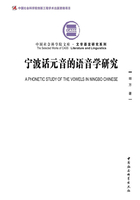
1.4 Outline of the stduy
This study consists of seven chapters.The present chapter introduces theoretical background concerning vowel production, phonological vowel description, acoustical correlates of vowels, and vowel articulation.The aims and scopes of the present study are discussed.In addition, a brief introduction of Ningbo Chinese is also presented.
Chapter Two presents the acoustical data of monophthong vowels collected from twenty Ningbo speakers, ten female and ten male.Based on the obtained frequency data, phonological vowel distinctions, such as vowel height, vowel backness, and vowel rounding are examined in terms of their acoustical correlates.Spectral characteristics of the short vowels and the apical vowels in Ningbo are also discussed.
In Chapter Three, the acoustical data of Ningbo diphthongs and triphthong from the same twenty speakers are presented.The main issue concerned is how to characterize the diphthongs acoustically.In languages with a relatively poor inventory of diphthongs, especially those without rising diphthongs such as English, both onset and offset elements of a diphthong are believed to be unimportant in the characterization of diphthongs, and what is of importance is the dynamic property of diphthongs, especially the rate of change in F2 (Gay, 1968, 1970).However, acoustical studies of languages with a rich inventory of diphthongs show that the F2 rate of change fails to distinguish all diphthongs from one another, and other factors, too, may contribute to the characterization of diphthongs (Manrique, 1979; Ren, 1986; Ren & Chan, 1988).In this chapter, both static and dynamic properties of diphthongs are discussed based on the presented duration and frequency data, and the discussion is focused on the characterization of the Ningbo diphthongs.
Chapter Four explores the articulatory aspect of Ningbo vowel production based on the acquired EMA data from seven speakers, three female and four male.First, the tongue position data from individual speakers are presented to examine the relevant articulatory vowel features, such as height and backness, as vowel articulation mainly involves lingual gestures.A PARAFACT modeling (Harshman et al., 1977) is conducted to make best approximation of lingual gestures.The results give a speaker-independent representation of the tongue articulation of vowels, so that phonological vowel features, such as height and backness, can be better interpreted in articulatory terms.Second, the tongue-jaw coordination is investigated.Third, lip gestures are examined in terms of the obtained lip position data.Fourth, the articulation of the short vowels is investigated and compared with their normal-length counterparts.And finally, the articulation of the apical vowels, especially their lingual gestures, is investigated.
Chapter Five deals with the articulation of the Ningbo diphthongs and triphthong.First, the static articulatory configurations for the diphthong or triphthong elements are extracted from the acquired EMA data.Comparisons are then made between the articulatory configurations of the diphthong or triphthong elements and the corresponding vowel targets to determine the possible articulatory undershoot effect.Second, tongue kinematics is examined to explore the dynamic aspects of diphthong production.
In Chapter Six, acoustical, articulatory, and aerodynamic aspects of Ningbo nasal vowels and vowel nasalization are investigated.In the acoustical study, formants of Ningbo the nasal vowels and nasalized vowels are presented and then compared with their oral counterparts to determine possible formant shift phenomenon due to the presence of nasality.The articulatory study then investigates whether there is any articulatory difference between the production of the nasal vowels and their oral counterparts.The aerodynamic study mainly investigates the temporal structure of vowel nasalization and the quantification of the strength of nasality.
Chapter Seven summarizes the main findings and presents a general discussion on the articulatory-to-acoustic relations.
[1]Lindau (1978) was somewhat different in that, based on some new cineradiographic recordings, she claimed that vowel height and backness also correlate with the articulatory data.So, from her point of view, the vowel features of High and Back can be accounted for articulatorily and acoustically and auditorily.However, she admitted that other features such as Peripheral should be best described in the acoustic domain.
[2]D stands for diphthongs and T stands for triphthongs.